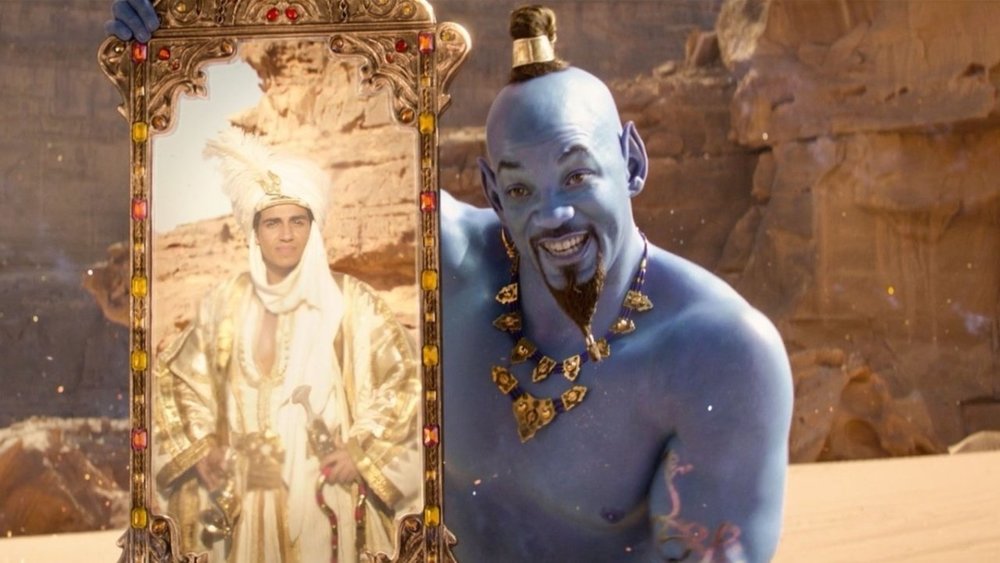
(Image: comicbook.com)
ALADDIN — 2 STARS
It is becoming increasingly tedious to both critique and enjoy these Disney “re-imaginings.” The teeter-totter between familiarity and freshness changes with each movie due to the modern desire to update and the soaring fan expectations set by the level of nostalgic adoration carried for each previous property. Diverge with heart and charm and you get the perfect Pete’s Dragon. Veer with questionable revisions or gaudy spectacle and you get the maligned Maleficent. Imitate and emulate with affection and you get Beauty and the Beast or Cinderella. Mix new tones with old ones for homage that don’t match and you get The Jungle Book and Dumbo. The results have been wildly mixed.
Where does the new Aladdin balance on this cinematic seesaw? That would be quite middle with a tilting lean that could go either way. The studio and Sherlock Holmes series director Guy Ritchie aimed admirably with an “ambitious and non-traditional” take employing minority casting against whitewashing and colorism. Those skin-deep improvements are progressive, but who are we kidding? The color that mattered most was blue. All the desired diversity in the world paled to who could possibly follow the late Robin Williams? The Genie is the ticket to more than just wishes when it comes to this reboot’s success.
That laborious task was given to Will Smith. Folks, he is a hot, baking sun of swagger! Will has not been this loose and free since Men in Black 3 seven years ago. Aladdin reminds us how much of a consummate showman the 50-year-old is and always has been. Will has a style, energy, and stage presence all his own, and he saves this entire movie from sandy ruin.
In front of The Genie’s winking and bejeweled human form and his sizable and mystical sapphire sinew is a slightly thickened story true Disney fans know by heart. A handsome “street rat” sneaker named Aladdin (Canadian-Egyptian newcomer Mena Massoud of Hulu’s Jack Ryan) catches the appreciative and alluring eye of Jasmine (pink Power Ranger Naomi Scott), the Princess of Agrabah, an independent spirit lamenting the trappings of her regal stature and required betrothal to fellow royalty. The handsome hustler also gains the prophecy-fulfilling curiosity of Jafar (Marwan Kenzari of Ben-Hur), the hypnotizing top advisor to the Sultan (12 Strong’s Navid Negahban), who is convinced the young man is the human key to the Cave of Wonders and a certain handheld beacon that likes being caressed by fingertips.
LESSON #1: EXCEEDING ONE’S INITIAL OR CURRENT PLACE — The moral dilemma of Aladdin has not changed. We have many “waited my whole life”-spewing characters trapped by their present or past places in society, complete with the corresponding weaknesses of confidence that accompany those tiers. Birthright, caste, hierarchy, gender, legislation, and other constraints like that pesky lamp all stand as potential causes. As the film and one of its new songs implores, too many good people are “seen and not heard.” Truthful resolve and manufactured personal improvement are the dueling paths sought to change one’s “speechless” or limited circumstances.
Heading back to the symbolic piece of playground equipment, the casting and performances in Aladdin are one step forward and two steps back. Massoud and Scott represent closer matching minorities for the affair and their attractive chemistry together has smoldering warmth. Massoud’s winning smile will swoon many. For today’s empowering present, Scott’s Jasmine was positively bolstered with layers of independence and, thankfully, less sexualization than previous incarnations. As an avian cherry on top, less Gilbert Gottfried, as in zero Gilbert Gottfried, is a blessing to the eardrums.
Unfortunately, the not-so-thin varnish of multiple unfavorable Arabic and Asian tropes, from accents to character behaviors, smears the rest of the human landscape of Aladdin. Negahban’s Sultan, for example, is terribly one-dimensional where even the doting towards his daughter is too slight to resonate as regality. The bigger vacuum is the main villain. Kenzari’s Jafar suffers from underwritten motivation and a somewhat unimposing performance. Had the same updating attention given to the Jasmine role been extended to that character by writers John August (Dark Shadows) and Guy Ritchie, the overall improvement could have increased the storytelling heights.
LESSON #2: REPRESENTATION ISN’T ENOUGH — The on-and-off irregularity of Aladdin is a unique situation. Yes, it is wonderful Disney sought people of color for this ethic fairy tale, but the clout of their portrayals and the substance of their actions are not improvements. If you’re going to do the right thing by diversity, go all the way, not just halfway or selectively. Dare to combat stereotypes completely.
Little expense was spared on the ritzy designs of Aladdin but that wavering imbalance affected the artistic and technical side as well. The prolific female team of production designer Gemma Jackson (Finding Neverland) and set decorator Tina Jones (Assassin’s Creed) created expansively hued settings of showy detail. Oscar-nominated costume designer Michael Wilkins (American Hustle) adorned the cast of thousands occupying those stages with fabulous frock and studly threads. The surface is sadly where the effectiveness ends.
The digitally created depth behind the practical elements fails to impress. The vistas cannot keep up and do not blend well with the work Jackson, Jones, and their teams. The same can be said with the physicality. The urban parkour puppeteered by experienced stunt coordinator Adam Kirley and the incredible dance choreography by Jamal Sims (the second MVP of the picture who also doubles for Will Smith) bound with kinetic vivacity only to be sullied by unsteady and questionable editing that makes the twirls, swirls, and flourishes choppy.
The final hot-and-cold component of Aladdin is its rich music. Just as he did for 2017’s Beauty and the Beast revival, composer Alan Menken returned to his Oscar-winning score and songs. His involvement was vitally essential to maintaining a level of glow for the movie. The execution, however, is the tedious part. The new songs from the songwriting duo of Pasek and Paul (La La Land, The Greatest Showman) are too slight or misplaced in their moments. Massoud and Scott may look the parts, but their vocals cannot quite achieve all that is necessary for “A Whole New World,” arguably Disney’s greatest duet song in their expansive catalog (a bar that was, forgivably, not going to be topped). Once again, Will Smith and Jamal Sims save the day. Where the pipes fail on the audio tracks, the punchy footwork and gyrating gambols on camera provide the dazzle, making one wonder and wish Aladdin could have gone full Bollywood. Guy Ritchie used to have that panache so it’s surprising not to see on the biggest stage.

LOGO DESIGNED BY MEENTS ILLUSTRATED (#785)
from REVIEW BLOG - Every Movie Has a Lesson http://bit.ly/2EtbHKP







No comments:
Post a Comment